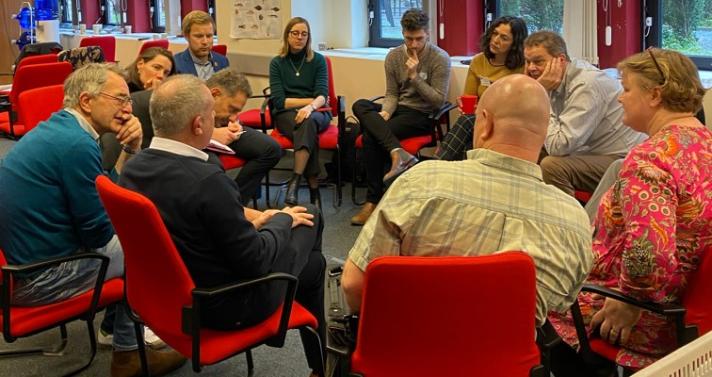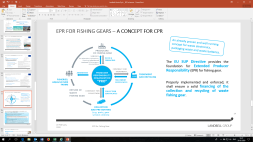Practical implications of the Directives
Under the revised PRF Directive, port facilities will have the obligation to include separate collection points for fishing gear and for passively fished waste in fishing harbours and apply a so-called 100% indirect fee system to incentivise landing of fished and operational waste. Member States should be encouraged to complement 100% indirect fee by alternative financing of the costs of collecting and managing fishing gear waste or passively fished waste ashore, including ‘fishing for litter schemes’ and extended producer responsibility schemes.
Under the SUP Directive, Member States have to set up extended producer responsibility (EPR) schemes for producers of fishing gear containing plastics. Producers will be financially responsible for the whole lifecycle of the product, including awareness raising, waste and end-of-life stage collection, transport and treatment. In addition, the SUP Directive requires Member States to report on fishing gear placed on the market and on waste fishing gear collected, as of 2022. Member States will also have to set up collection targets for fishing gear by July 2021.
State of the art
All harbours collect multiple types of waste, but there is no consistency between waste management systems. Best practices exists amongst others in the Baltic and in Ireland as regards collection of fishing gear. In the Baltic 70% of the harbours, collect end-of-life fishing gear, of which 28% permanently. In Ireland, all fishing ports take in fishing for litter (FFL) waste and 75% collect end-of-life gear. In most ports, the municipalities are responsible for waste collection, but different systems exist. In general, fishing vessels are mainly active in small ports and bring in small quantities of waste.
The obligation to set up EPR schemes is new for producers of fishing gear but has already been established for other products such as batteries or end-of-life vehicles. These schemes exist for many years and serve as a basis for setting up schemes for producers of fishing gear. EPR is in principle an individual producer responsibility, but producers can also team up and set up so-called producer responsibility organisations (PROs). In this case, all producers, including those outside Europe, are registered at the PRO, who handle the running and administration of EPR schemes and to which they report, as shown in the figure below. Existing EPR schemes have shown an increase in the recycled percentage as well as a reduction of weight per article. It also incentivise producers to design products for better and easier dismantling.
Main findings of the workshop
1. Mind-set and cooperation
A change of mind-set concerning fishing gear can be a big win. Fishing gear is part of the so-called SUP Directive, but it is important to note that it is not a single-use plastic but a multi-use item that is designed to be durable and resistant in marine environment. It has been included because it is one of the ten most found plastic items on EU beaches and when lost, it can have a negative impact on marine environment and marine resources. Therefore, labelling end-of-life gear as a potential resource and showing the value of the plastic materials included in it can influence a behavioural change. Thereby, displaying the possible use of recyclates from fishing gear, for example in picnic tables or sport products, could contribute to changing the mind-set.
In some countries, we can observe good relations and cooperation between fisheries communities, governments and the civil society, which results in best practices such as active participation in fishing for litter schemes or the Dutch Green Deal which also includes actions on marine litter. Building on the goodwill of fishermen and enhancing cooperation between all stakeholders is crucial, instead of creating separate systems that stakeholders don’t feel associated with.
2. Collection points
It was generally agreed that port authorities are key as enablers for collection of waste/end-of-life fishing gear and passively fished waste. They have an important role in coordination of the collection and transport of waste, as well as setting-up and providing of facilities. There are variations between Member States in responsible authorities in charge of setting-up and installation of collection points (municipalities, government department, waste management companies, contractors, NGOs..).
Separate collection of waste and end-of-life fishing gear, including sorting and dismantling, will increase manual labour efforts. There will be a need for clear roles for pre-processing between waste managers, port authorities and fishermen, and defining funding for the cost of this labour. Costs of dismantling, dedicated space needs and need for trained staff represent a challenge for the ports. The 100% indirect fee could possibly cover part of this, but bigger ports that collect most of the money through the fees do not collect most of the waste and end-of-life fishing gear and passively fished waste. There is a fear that the installation of new facilities would directly increase port fees. Possibility to use EMFF/EMFAF funding to cover part of the collection costs or costs for upgrading collection facilities was raised, but there were concerns that this fund could cover labour costs only of the fisheries sector. It was also highlighted that local authorities have difficulties to access the EMFF funding. It was suggested to have a combination between decentralized and centralized collection and handling.
The passively fished waste is currently delivered to ports, but mostly to those who participate in the fishing for litter schemes. Definition of passively fished waste versus fishing for litter waste is not clear.
Small and remote fishing harbours will the ones facing the biggest challenge in separate collection and will also have the biggest difficulties to access alternative funding. The participants also pointed out lack of adequate space for new waste streams and pre-sorting activities in ports as a further challenge.
3. EPR schemes
Under the EPR schemes, producers will be responsible for the whole life cycle of products, as well as for the financing of the end-of-life stage. There is also a requirement for producers to contribute financially to awareness raising on disposal options and consequences of an inappropriate disposal.
The workshop highlighted that the market of fishing gear is relatively small compared to other products covered by EPR schemes, volumes collected for recycling are quite limited and recycling is quite costly. Therefore, participants advocated rather for the setting up of a harmonized EPR system throughout Europe (or at regional level) fitting the size of the sector rather than using individual approach with 23 different EPR schemes.
Different factors are yet unclear. The biggest unknown is the definition of a producer under the EPR schemes (producers, assemblers, wholesalers, importers, repairers). It will be important for the Member States to clarify who is considered a producer in order to secure proper financing. Moreover, it is unclear how will producers be held accountable for end-of-life treatment in 3rd countries (even outside of Europe)? How will awareness raising be organized? If it is well organized, awareness raising can be very positive, for example in decreasing the impact of cut-offs. In order to face situations when producers are no longer at the market but their products still require end-of-life treatment, EPR schemes may provide financial guarantees that could be used in such situations.
4. Reporting requirements
The reporting of fishing gear should be in an easy format, preferably linked to existing systems, such as the OSPAR categorization of plastics. The unit for reporting should be in kg weight, as the gears are also sold in this unit. A simple database could be used to prevent difficult reporting systems via many stakeholders. There has to be a central coordinator, but participants noted that fisheries organizations, NGO’s and municipalities could not carry the load. The question of information to be reported (by type of gear or type of waste) is to be decided, but this should not add on administrative burden.
Reporting on fishing gear placed on the market -
In general, it is deemed complex to match the EPR and the PRF developments, and it is very important that the Directives will be properly implemented, as this is often a gap.
Side notes were made on the challenges for recycling of fishing gear. Landfill and incineration is relatively cheap due to subsidies, recycling can be up to 3 times as expensive. On the other hand, recycling of plastic can reduce CO2 emission up to 82% compared to virgin plastics. Thereby sorting of materials (currently there are more than 700 types of ropes) is key to ensure high quality recyclates.
Next steps
The Commission will further engage with stakeholders, also with less active Member States. On the 29th of April, the Commission will organise a workshop with authorities responsible for the implementation of the SUP and PRF directives, as well with relevant stakeholders, on the reporting requirements for fishing gear and passively fished waste.
Catherine Barrett (BIM) engagement with fishermen
Mike Mannaert (KIMO) fishing for litter
Aneta Zych (Landbell) Extended Producer Responsibility
Ewoud Kuin (Dutch Ministry) Dutch approach to Green deal
Arir Nijdam (Voms) value of marine litter
Bernard Merkx (plastix) re-use, repair, recycle
Andrea Stolte (WWF) collection and management of retrieved fishing gear
|
Full name |
Organisation |
|
Michael Mannaart |
KIMO |
|
Catherine Barrett |
BIM |
|
Senne Aertbeliën |
Belgium |
|
Pernille Cuisy Svensson |
Denmark |
|
Ewoud Kuin |
Netherlands |
|
Heikki Lehtinen |
Finland |
|
Mirja Ikonen |
Finland |
|
Stefanie Werner |
Germany |
|
Ville Rinkineva |
Estland |
|
Jacob Armstrong |
ESPO |
|
Alberto Jaraiz |
Port of Vigo |
|
Patrick Murphy |
Ireland ports |
|
Sophie Delair |
EUROSHORE (prf) |
|
Katarzyna Hlebowicz-Wojciechowska |
Port of Gdynia |
|
Kirsti Tarnanen-Sariola |
Finish ports association |
|
Cormac McGinley |
Harbour master Castletown Berehaven |
|
Noel Dillon |
Engineer Castletownbere |
|
Pim Visser |
NSAC |
|
Marc-Philip Buckhout |
Aquaculture AC |
|
Nadia Moalla Gil |
CEPESCA |
|
Aneta Zych |
Landbell Group |
|
Bernard Merkx |
Waste free oceans/Plastix |
|
Arie Nijdam |
VOMS |
|
Johan Verlinden |
OVAM |
|
Ilias Prevezas |
Hellenic Environmental Center |
|
Nicolas HUMEZ |
Hazardous waste europe |
|
Philippe Verschueren |
EUROCORD |
|
Rodney O'Sullivan |
Swan Net Gundry |
|
Tuomo Leino |
Rapala |
|
Andrea Stolte |
WWF |
|
Joan Drinkwin |
GGGI |
|
Siegfried Anton Schmuck |
Sciaena |
|
Timothy Grabiel |
EIA international |
|
Marek Press |
Keep the Estonian Sea Tidy Association |
|
martin charter |
University for the creative arts |
|
Sally Clink |
BSAC |
|
Marta Ruiz |
HELCOM |
|
Mehmet Kerem Kemerli |
Oil spill management? |
|
Paul Altena |
Cruising industry |
|
Reet Laos |
Estonian ministry of economic affairs and communications |
|
Sirje Stén |
Finish Ministry of Environment |
|
Séverine Renault |
Consultant |
|
Samuel Djavidnia |
EMSA |
|
Michail Papadoyannakis |
DG ENV |
|
Alena Petrikovicova |
DG MARE |
|
Maris Stulgis |
DG MARE |
|
Anna Bobo Remijn |
DG ENV |
|
Rikke Nielsen |
DG MOVE |
|
Bernike van Werven |
DG MARE |


